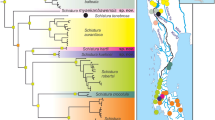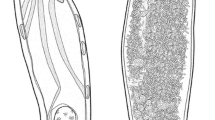Abstract
The type material of Polylekithum ictaluri, P. halli, and Maculifer chandleri was examined from the United States National Parasite Museum, and we determined that the material was conspecific, making P. halli and M. chandleri junior subjective synonyms of P. ictaluri. Polylekithum catahoulensis sp. nov. was described from material collected from catfishes at the Catahoula Wildlife Refuge, LaSalle Parish, Louisiana, USA, and compared with P. ictaluri collected from catfishes in Reelfoot Lake, Obion County, Tennessee, USA, and the Pearl River, Hancock County, Mississippi, USA. Polylekithum catahoulensis had smaller eggs (77–88 μm long by 51–63 μm wide vs. 94–108 μm by 52–76 μm) and a longer forebody (35–41% of overall body length vs. 29–34%). Comparison of more than 2,400 bp long fragments of nuclear ribosomal DNA (complete ITS and partial 28S regions) strongly supported the status of P. catahoulensis as a new species. Molecular phylogenetic analysis of 28S rDNA gene sequences from Polylekithum as well as representative species from Allocreadiidae, Atractotrematidae, Brachycoeliidae, Callodistomidae, Dicrocoeliidae, Encyclometridae, Gorgoderidae, Haploporidae, Opecoelidae, Plagiorchiidae, and Telorchiidae rooted by Monorchiidae and Lissorchiidae demonstrated that of the families tested, Polylekithum was most closely related to Encyclometridae as a gorgoderoid and not to Allocreadiidae as previously reported. Morphological features of three South American allocreadiids, Allocreadium patagonicum, P. percai, and A. pichi were inconsistent with generic diagnoses of Allocreadium and Polylekithum, so we suggested they belonged in a single unnamed genus similar to Creptotrema. Polylekithum catlai from India was assessed from the description and failed to conform to the generic diagnosis of Polylekithum. Morphology of Caudouterina suggested a close relationship with Polylekithum and not Allocreadiidae.
Similar content being viewed by others
References
Arnold J.G. 1934. Some trematodes of the common bullhead Ameiurus nebulosus (Le Sueur). Transactions of the American Microscopical Society, 53, 267–276.
Cable R.M. 1956. Opistholebes diodontis n. sp., its development in the final host, the affinities of some amphistomatous trematodes from marine fishes and the allocreadioid problem. Parasitology, 46, 1–13.
Caira J.N. 1989. A revision of the North American papillose Allocreadiidae (Digenea) with independent cladistic analyses of larval and adult forms. Bulletin of the University of Nebraska State Museum, 11, 1–91.
Caira J.N., Bogéa T. 2005. Family Allocreadiidae Looss, 1902. In: Keys to the Trematoda. Vol. 2 (Eds. A. Jones, R.A. Bray and D.I. Gibson). CABI Publishing, Wallingford, UK, 417–436.
Clopton R.E. 2004. Standard nomenclature and metrics of plane shapes for use in gregarine taxonomy. Comparative Parasitology, 71, 130–140.
Flores V.R., Brugni N., Ostrowski de Núñez M. 2004. Allocreadium pichi n. sp. (Trematoda: Allocreadiidae) in Galaxias maculatus (Osteichthyes: Galaxiidae) from Lake Moreno in Patagonia (Argentina). Systematic Parasitology, 58, 217–221.
Gibson D.I. 1996. Trematoda. In: Guide to the parasites of fishes of Canada. Part IV (Eds. L. Margolis and Z. Kabata). Canadian Special Publication of Fisheries and Aquatic Sciences, 124.
Harwood P.D. 1935. Maculifer chandleri, n. sp. (Allocreadiidae), a trematode from Texas catfish. Helminthological Society of Washington, 2, 75–76.
Hoffman G.L. 1999. Parasites of North American freshwater fishes. Cornell University Press.
Jeanmougin F., Thompson J.D., Gouy M., Higgins D.G., Gibson T.J. 1998. Multiple sequence alignment with Clustal X. Trends in Biochemical Sciences, 23, 403–405.
Jones A. 2005. Superfamily Haploporoidea Nicoll, 1914. In: Keys to the Trematoda. Vol. 2 (Eds. A. Jones, R.A. Bray and D.I. Gibson). CABI Publishing, Wallingford, UK, 127–128.
Jousson O., Bartoli P. 2001. Molecules, morphology and morphometrics of Cainocreadium labracis and Cainocreadium dentecis n. sp. (Digenea: Opecoelidae) parasitic in marine fishes. International Journal for Parasitology, 31, 706–714.
Jousson O., Bartoli P. 2002. Species diversity among the genus Monorchis (Digenea: Monorchiidae) parasitic in marine teleosts: molecular, morphological and morphometrical studies with a description of Monorchis blennii n. sp. Parasitology Research, 88, 230–241.
Kakaji V.L. 1969a. Studies on helminth parasites of Indian fishes. Part III. Some trematode parasites of fresh water fishes of Uttar Predesh. Indian Journal of Helminthology, 21, 49–80.
Kakaji V.L. 1969b. Studies on helminth parasites of Indian fishes. Part III. On some species of the genus Allocreadium Looss, 1900. Annales de Parasitologie Humaine et Comparée (Paris), 44, 131–146.
Kohn A., Fernandes B.M.M. 1976. Sobre uma nova espécie do gênero Leurosoma Ozaki, 1932 (Trematoda, Allocreadiidae) parasito de ofidio. Atas da Sociedade de Biologia do Rio de Janeiro, 18, 87–89.
Maddison D.R., Maddison W.P. 2000. MacClade4: analysis of phylogeny and character evolution. Sinauer Associates, Sunderland, Massachusetts, USA.
Manter H.W. 1970. The terminology and occurrence of certain structures of digenetic trematodes, with special reference to the Hemiuroidea. In: H.D. Srivastava Commemorative Volume (Eds. K.S. Singh and B.K. Tandon). Indian Veterinary Research Institute, Izatnagar, 27–33.
Martin G.W. 1966. Caudouterina rhyacotritoni gen. et sp. n. (Trematoda: Digenea) from the Olympic salamander. Journal of Parasitology, 52, 935–938.
Mueller J.F., Van Cleave H.J. 1932. Parasites of Oneida Lake fishes. Part II. Roosevelt Wild Life Annals, 3, 73–154.
Odening K. 1960. Der Ansatzmodus des Exkretionsgefässsystem und die systematische Stellug von Encyclometra (Trematoda, Digenea). Monatsberichte der Deutschen Akademie der Wissenschaften zu Berlin, 2, 445–449.
Odening K. 1968. Exkretionssystem und systematische Stellung der Trematodengattungen Anchitrema, Cephalogonimus, Encyclometra, Mesotretes, Omphalometra und Urotrema. Monatsberichte der Deutschen Akademie der Wissenschaften zu Berlin, 10, 492–498.
Olson P.D., Cribb T.H., Tkach V.V., Bray R.A., Littlewood D.T.J. 2003. Phylogeny and classification of the Digenea (Platyhelminthes: Trematoda). International Journal for Parasitology, 33, 733–755.
Olson P.D., Tkach V.V. 2005. Advances and trends in the molecular systematics of the parasitic Platyhelminthes. Advances in Parasitology, 60, 165–243.
Ostrowski de Núñez M., Brugni N., Viozzi G. 2000. Polylekithum percai n. sp. (Trematoda: Allocreadiidae) from Percichthys trucha (Perciformes: Percichthydae) in Patagonia, Argentina, and a redescription of Homalometron papilliferum (Szidat, 1956) n. comb. Systematic Parasitology, 47, 51–57.
Overstreet R.M., Curran S.S. 2005. Family Haploporidae Nicoll, 1914. In: Keys to the Trematoda. Vol. 2 (Eds. A. Jones, R.A. Bray and D.I. Gibson). CABI Publishing, Wallingford, UK, 129–174.
Overstreet R.M., Curran S.S., Pote L.M., King D.T., Blend C.K., Grater W.D. 2002. Bolbophorus damnificus n. sp (Digenea: Bolbophoridae) from the channel catfish Ictalurus punctatus and American white pelican Pelecanus erythrorhynchos in the USA based on life-cycle and molecular data. Systematic Parasitology, 52, 81–96.
Pearse A.S. 1924. Observations on parasitic worms from Wisconsin fishes. Transactions of the Wisconsin Academy of Sciences, Arts, and Letters, 21, 147–160.
Peters L.E. 1961. The genus Skrjabinopsolus (Trematoda: Digenea), with reference to the allocreadioid problem. American Midland Naturalist, 65, 436–445.
Platt T.R., Tkach V.V. 2003. Two new species of Choanocotyle Jue Sue and Platt, 1998 (Digenea: Choanocotylidae) from an Australian freshwater turtle (Testudines: Pleurodira: Chelidae). Journal of Parasitology, 89, 145–150.
Platta C.S., Choudhury A. 2006. Systematic position and relationships of Paracryptotrematina limi, based on partial sequences of 28S rRNA and cytochrome c oxidase subunit 1 genes. Journal of Parasitology, 92, 411–413.
Seitner P.G. 1951. The life history of Allocreadium ictaluri Pearse, 1924 (Trematoda: Digenea). Journal of Parasitology, 37, 223–244.
Shimazu T., Urawa S., Coria C.O. 2000. Four species of digeneans, including Allocreadium patagonicum sp. n. (Allocreadiidae), from freshwater fishes of Patagonia, Argentina. Folia Parasitologica, 47, 111–117.
Snyder S.D., Tkach V.V. 2001. Phylogenetic and biogeographical relationships among some holarctic frog lung flukes (Digenea: Haematoloechidae). Journal of Parasitology, 87, 1433–1440.
Swofford D.L. 2002. PAUP* version 4.0b10: phylogenetic analysis using parsimony (and other methods). Sinauer Associates, Sunderland, Massachusetts, USA.
Tkach V.V., Pawlowski J. 1999. A new method of DNA extraction from the ethanol-fixed parasitic worms. Acta Parasitologica, 44, 147–148.
Tkach V.V., Pawlowski J., Mariaux J., Swiderski Z. 2001. Molecular phylogeny of the suborder Plagiorchiata and its position in the system of Digenea. In: Interrelationships of the Platyhelminthes (Eds. D.T.J. Littlewood and R.A. Bray). Taylor & Francis, London, 186–193.
Tkach V.V., Pawlowski J., Sharpilo V.P. 2000. Molecular and morphological differentiation between species of the Plagiorchis vespertilionis group (Digenea, Plagiorchiidae) occurring in European bats, with a re-description of P. vespertilionis (Muller, 1780). Systematic Parasitology, 47, 9–22.
Tkach V.V., Littlewood D.T.J., Olson P.D., Kinsella J.M., Swiderski Z. 2003. Molecular phylogenetic analysis of the Microphalloidea Ward, 1901 (Trematoda: Digenea). Systematic Parasitology, 56, 1–15.
Van Cleave H.J., Mueller J.F. 1934. Parasites of Oneida Lake fishes. Part III. Roosevelt Wild Life Annals, 3, 159–334.
Yamaguti S. 1958. Systema helminthum. Vols 1 and 2. The digenetic trematodes of vertebrates. Interscience Publishers Inc., New York.
Yamaguti S. 1971. Synopsis of digenetic trematodes of vertebrates. Vols I and II. Keigaku, Tokyo.
Author information
Authors and Affiliations
Corresponding author
Rights and permissions
About this article
Cite this article
Curran, S.S., Tkach, V.V. & Overstreet, R.M. A review of Polylekithum Arnold, 1934 and its familial affinities using morphological and molecular data, with description of Polylekithum catahoulensis sp. nov.. Acta Parasit. 51, 238–248 (2006). https://doi.org/10.2478/s11686-006-0037-1
Accepted:
Issue Date:
DOI: https://doi.org/10.2478/s11686-006-0037-1




